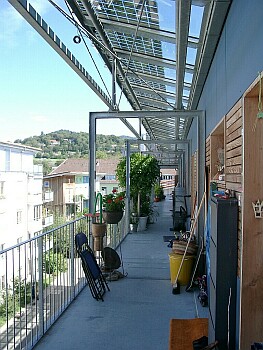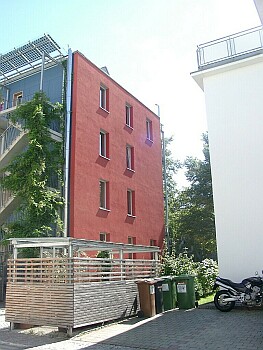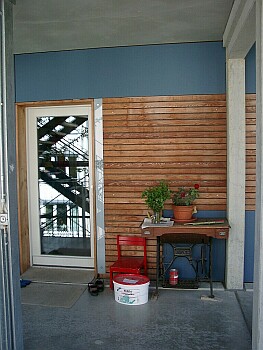de | en | fr | tr
Passive house »Wohnen & Arbeiten«
Walter-Gropius-Strasse 22 • D-79100 Freiburg • Germany • Vox: +49 761 4568330Email: post(at)passivhaus-vauban.de • Web: www.passivhaus-vauban.de
| The Idea | |
| What is a Passive house? | |
| Energy Concept | |
| Research Outcomes | |
| The Cost | |
| Co-generation Unit | |
| Architecture | |
| Residents, Owners | |
| Guided Tours | |
| Download | |
| Privacy policy | |
| Credits | |
The Idea
| North Access Balcony, 3. OG | |
 |
|
| Click on the picture to enlarge:1024 x 768 | |
| West Facade | |
 |
|
| Apartment Entrance | |
 |
A passivehouse is an extreme energy-saving house, even when compared to new buildings. The first passivehouse as a multifamily residence came into being in 1999, in Freiburg im Breisgau, Germany. In "Passivhaus Wohnen & Arbeiten", it is proven that 79% primary energy saving (including electrical power) is possible, without sacrificing comfort, for only 7% extra cost than the cost of a conventional new building. The gain from saved energy is able to pay for the 7% extra cost in 10 to 20 years.
History
Sometime in the year 1995, when it was already clear that the former french barracks "Quartier Vauban" had to be replaced, a biologist Jörg Lange, and an architect, Michael Gies met in their working place everyday while getting coffee or making copies. (At that time, they were sharing their office -a former barrack which unfortunately does not exist anymore- with Forum Vauban, where the development of Vauban district originated.)
Michael Gies said: "I would like to build a multifamily-passive house!" - And Jörg Lange said: "I would like to implement an alternative sanitation concept in a house." - and so it happened.
The idea was clear: It had to be a cost-efficient, energy optimizing multifamily residence -passivehouse architecture-. Furthermore, it had to be equipped with vacuum toilets, the excrements and the urine (also called black water) had to be disposed in a biogas reactor in which biogas would be produced and be used for cooking. The remaining sewages had to be treated in a sewage-treatment plant so that the building could also be a wastewater-free house.
Two concepts are implemented in the house: The energy concept of a passive house, endowed with a gas-operated co-generation unit and the alternative sanitation concept.
Relatively quickly there were quite a few people interested in the project and also some investors. Since both Lange and Gies were well enrooted -they still are- in Freiburg's "energy scene", the idea of building a passive house attracted great outright interest.
With the help of Forum Vauban, one of the first assembly groups was created. This assembly group was a union of private owners who took the organization of the construction in the hand. There was already an architect in the group, so the next thing was to commit themselves to finding partners: The Fraunhofer-Institute for Solar Energy Systems with Martin Ufheil (now "solares bauen") was ready to carry out a research project about a multifamily residence passive house. At that time, -to our knowledge- there were indeed already a few passive row houses in Germany, but no multifamily residence passive houses. All participants received a lot of valuable information from Passive house-Institute in Darmstadt.
Jörg Lange passed two research proposals to
German- Environment Foundation and received both marks of the award:
- Alternative Sanitary concept: (text in German)
DBU-Proposal for it (in German) - Energy concept:
DBU-Proposal for it (in German)
The planning period ran from 1996 to 1999. The construction began in 15.7.1998 and ended sometime around July/August of 1999. In the meantime (till 2005), we have gathered the records of 6 heating periods. The results are consistently only positive.